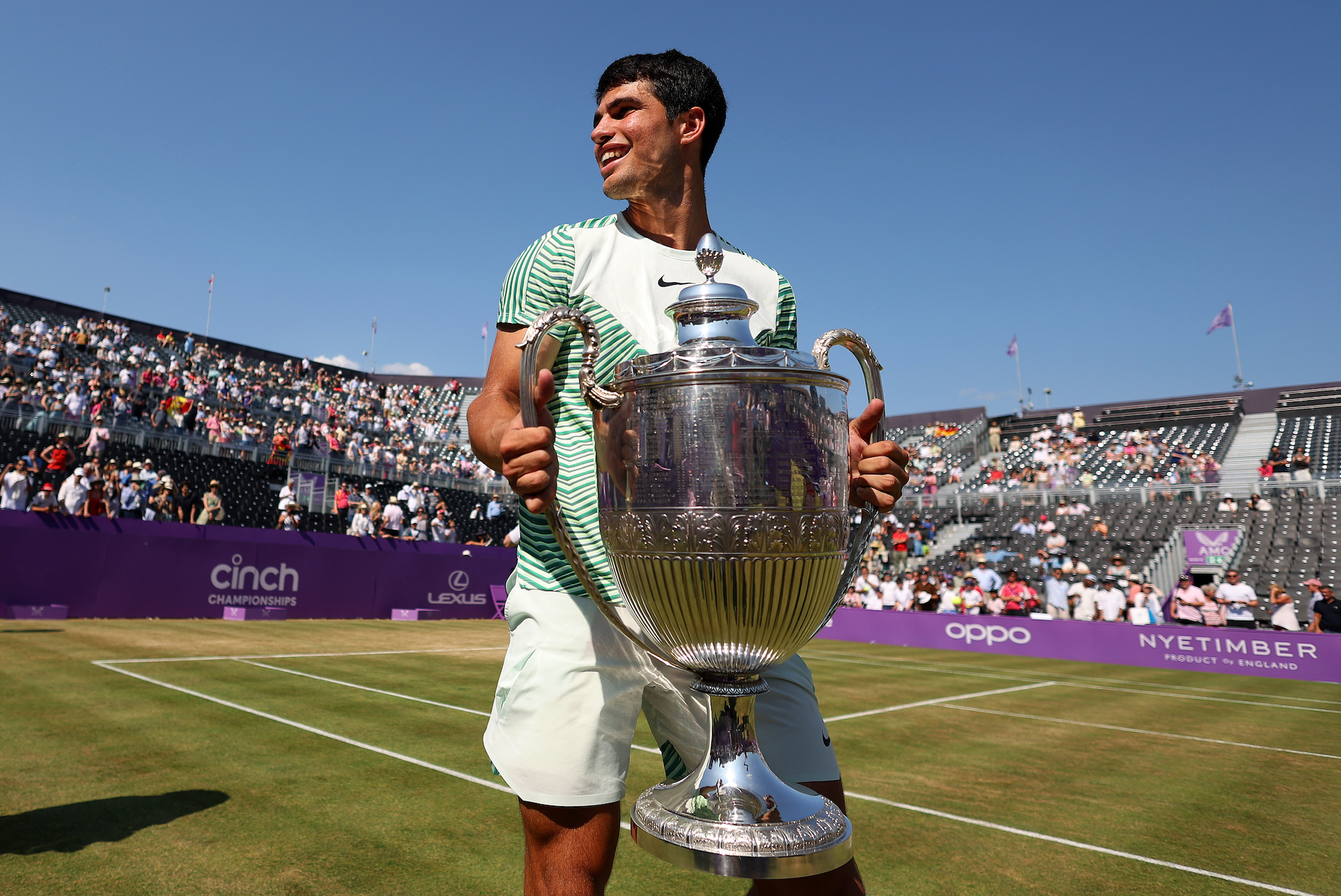There's probably an accurate, scaled-down Carlos Alcaraz version of Malcolm Gladwell's dopey dictum about 10,000 hours. If there is a tennis skill that needs learning, it will take Carlos Alcaraz roughly 100 hours on the job to master it. At the top end. Possibly just a quarter of that. Alcaraz, who grew up on clay courts and has since conquered hard courts, is still quite green when it comes to grass. As of today, Alcaraz has played a cumulative 25 hours and 54 minutes of grass-court tennis in his pro career, and he already has a trophy to show for it. Alcaraz triumphed at Queen's Club on Sunday, claiming his first title on the surface, with a 6-4, 6-4 victory in the final over Alex de Minaur. The progression was quick. After winning his first-round match he said, "Honestly, my expectations in this tournament are not too high." Halfway through the week, he wrote that he was "learning and having fun on this surface!" followed by what Unicode describes as the "disguised face" and the "partying face." By the weekend he was hoisting one of the most voluminous (if not most significant) trophies in tennis, then cooling off with some mini golf.
Alcaraz's unfamiliarity with vegetal tennis is pretty standard for a young player. Grass courts appear on a brief slice of the pro calendar, are uncommon worldwide, and don't feature much in the junior game. Alcaraz made his pro debut on the surface at Wimbledon 2021, a few months before his takeover began in earnest, when he was just an 18-year-old playing well enough to receive a wild card. He won one match and was scrubbed out of the second round by a superior Daniil Medvedev. By the time Alcaraz returned to Wimbledon 2022, he was already good enough to chew through some veteran competition and make the fourth round, where he lost a thriller to his occasional rival Jannik Sinner.
Now Alcaraz is in his third-ever grass season, and he is approaching it with greater intent, signing up for a pre-Wimbledon warm-up event to get more reps in—and winning it, just for good measure. To hear him tell it, the key adjustment for him on grass is style of movement. Blades of grass are slippery, in a different way that crushed red brick is slippery; it's a difficult surface to defend on, as the ball stays lower to the ground and shoes can lose traction when changing direction. Alcaraz has said that his prep involved watching videos of excellent grass-court movers like Roger Federer and Andy Murray. (Less of Novak Djokovic, who prefers to slide on grass, a technique that Alcaraz says he has yet to embrace.) "I have to be really focused on every move, every shot, so for me, it's more tiring when you're moving on grass, I have to do a specific work to move on grass," he said at the start of last week. No movement challenge is insurmountable for Alcaraz, who is probably already the tour's best mover on hard court and clay. Once he comes to understand the finer points of grass court movement, he will probably discover that his tennis DNA—sensitive hands, improvisational instincts, and constant aggression—will actually be rewarded on the surface.
It wasn't the most comfortably won of Alcaraz's 11 titles—the first round and championship match each had their dicey moments—but in the end he wound up with another milestone, in a career that seems to consist entirely of them. The 20-year-old became the fifth-youngest player ever to secure titles on all three surfaces. Of active players, only Rafael Nadal, Novak Djokovic, and Andy Murray own titles on all three surfaces at the 500-level and up. None of those men accomplished the feat this quickly. Even as he openly admits doubts about his play on grass, Carlitos is probably the most complete 20-year-old ever to play the men's game. As a result of this win, Alcaraz's ranking has inched back in front of Novak Djokovic, who has been resting since winning the French Open and seizing the men's major-title record. The novice with just 11 grass matches to his name will be the No. 1 seed at Wimbledon.






